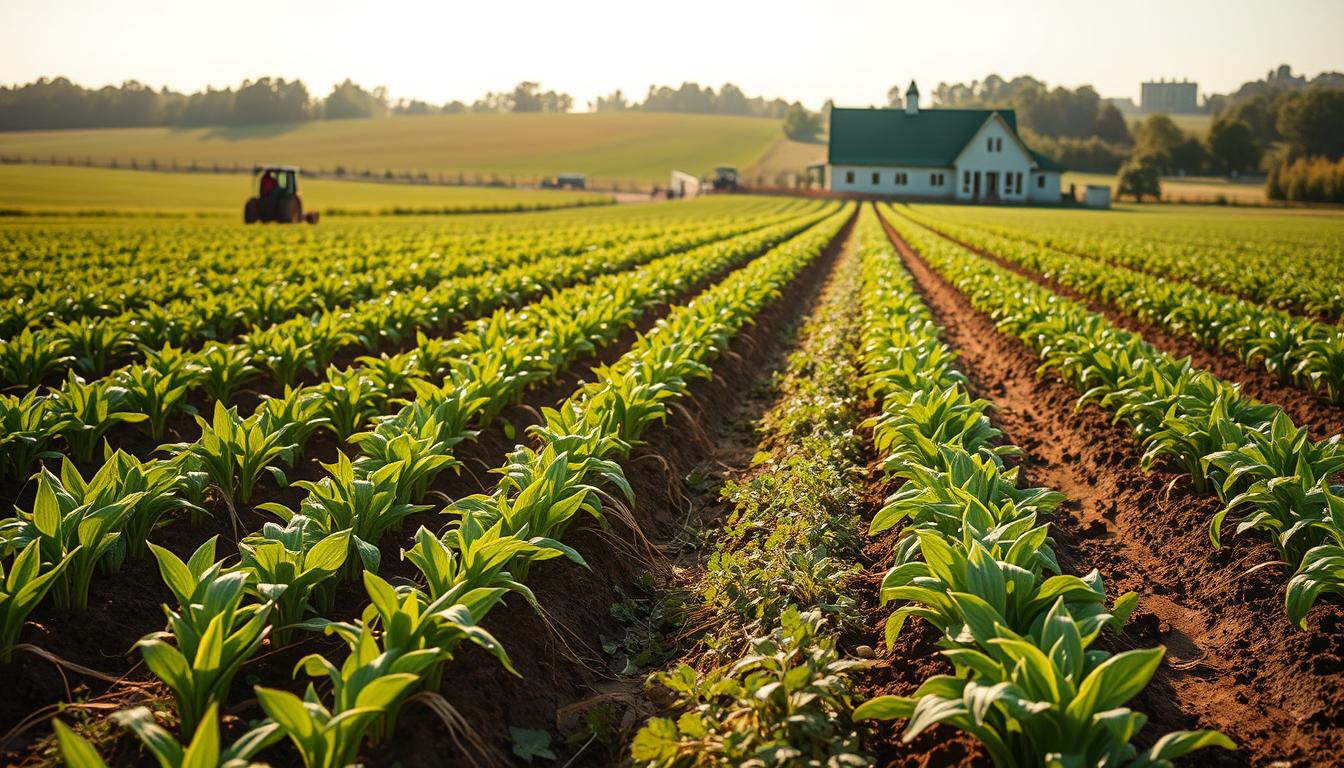Farmers today face a big challenge. They need to grow more food while keeping our environment safe. Smart field planning is a key solution that doesn’t rely on lots of chemicals.
By changing what grows where and when, farmers can improve soil quality and increase harvests. This approach is both natural and effective.
New methods in sustainable agriculture move beyond the old three-field system. They use data and science to create custom planting plans. These plans work with nature, not against it.
These systems help break pest cycles, reduce erosion, and keep nutrients in the soil. They are beneficial for any farm, big or small.
These updated practices can cut costs on fertilizers and pesticides. They also help build long-term land health. The benefits go beyond the farm, supporting cleaner water, healthier ecosystems, and more resilient food systems.
The Urgent Need for Sustainable Farming Practices
Farming today faces many challenges, making sustainable agriculture crucial. The old ways of farming, like the Green Revolution, are no longer enough. Farmers know they must change how they grow food to survive.
Current Agricultural Challenges
Over 33% of the world’s topsoil has degraded, with losses much higher than gains. This hurts our food’s quality and how well it grows.
Chemical resistance is also a big problem. More than 500 insects, 270 weeds, and many plant diseases have become resistant. Climate change adds to the stress, with unpredictable weather and extreme weather events.
Water pollution from farms affects nearly 80% of U.S. waterways. Farmland’s biodiversity is also dropping fast. We need more than one solution to fix these issues.
Why Rotation Systems Matter Now More Than Ever
Crop rotation is a key solution. It tackles many problems at once by working with nature, not against it.
Farmers using crop rotation use 50-80% less chemicals and keep yields high. The Rodale Institute shows that good rotation builds soil health and keeps water in the soil.
Rotation systems also help farmers financially. In the 2012 Midwest drought, farms with diverse rotations lost 30% less than others. These methods work for any farm size, leading to sustainable farming.
The Science Behind Effective Crop Rotation Techniques
Modern crop rotation techniques use science to make fields thrive. Farmers learn these principles to improve soil health and yields. This approach also cuts down on synthetic inputs, making farms more sustainable and profitable.
Good rotation systems work with nature, not against it. They use biological processes that have been around for millions of years. By aligning farming with these natural cycles, growers create strong agricultural systems. These systems can handle environmental stresses while staying productive.
Let’s look at the key science behind crop rotation. Knowing these concepts helps you plan rotations that solve your farming problems.
Understanding Soil Ecology
Soil is more than just dirt; it’s a living ecosystem full of billions of organisms. A teaspoon of healthy soil has more microbes than all people on Earth. These microbes work with plant roots to improve crop health and productivity.
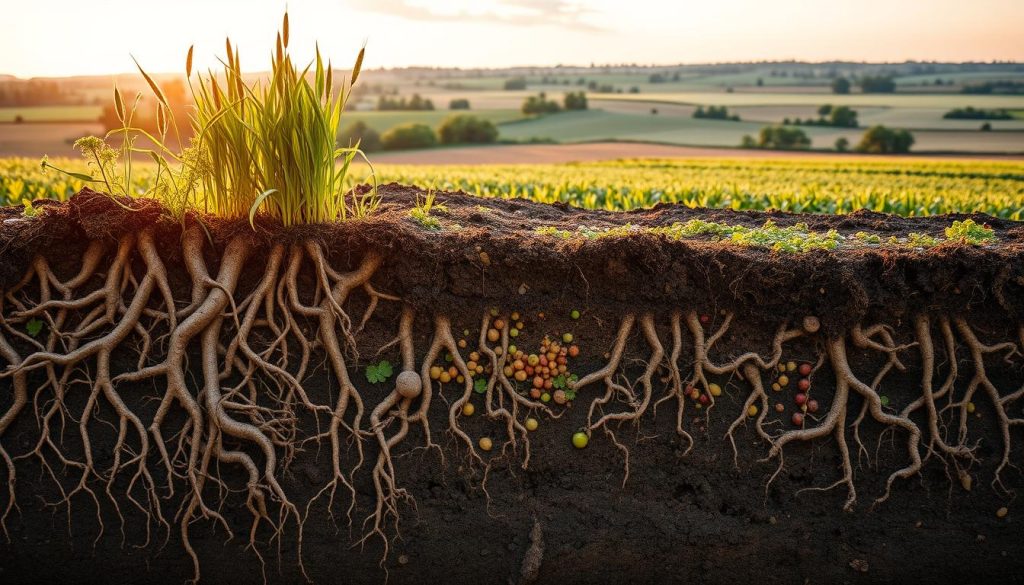
Different crops support different soil microbes. Legumes, for example, help beneficial bacteria fix nitrogen. Deep-rooted crops like sunflowers improve soil structure and water flow. Rotating crops diversifies these microbial communities, creating a balanced soil ecosystem.
This living soil network helps plants get nutrients, fights off pathogens, and builds soil structure. Thoughtful crop rotation enhances this biological activity. It’s the basis of sustainable soil fertility management.
Nutrient Cycling and Availability
Each plant family interacts with soil nutrients in its own way. Some crops use a lot of nutrients, while others add to soil fertility. Smart rotation balances these interactions to keep nutrients at the right levels without too much fertilizer.
Legumes like soybeans, peas, and clover work with rhizobium bacteria to make nitrogen available to plants. This process, called nitrogen fixation, can provide 40-60% of the nitrogen needed by other crops.
Deep-rooted crops get nutrients from deeper soil layers that shallow-rooted plants can’t reach. When these nutrients decompose, they become available to future crops. This natural process is key to effective soil fertility management.
| Crop Family | Nutrient Contribution | Soil Impact | Rotation Benefits |
|---|---|---|---|
| Legumes | Nitrogen fixation | Improves soil structure | Reduces fertilizer needs |
| Brassicas | Sulfur cycling | Biofumigation effects | Suppresses soil pathogens |
| Grasses | Carbon sequestration | Builds organic matter | Enhances water retention |
| Root crops | Phosphorus mobilization | Breaks compaction | Improves soil aeration |
Breaking Pest and Disease Cycles
Many pests and pathogens target specific plant families. Growing the same crop repeatedly in the same field lets these organisms build up. Effective crop rotation breaks these cycles by removing host plants at the right time.
For example, corn rootworm larvae hatch looking for corn roots. If soybeans are planted instead, they starve. Many fungal diseases that harm tomatoes can’t survive without solanaceous hosts. Rotating to unrelated crops naturally reduces pest pressure.
The timing of rotations is also important. Some pathogens can stay in soil for years, while others die off quickly. Knowing these cycles helps farmers plan rotations that suppress pests without chemicals.
Essential Crop Rotation Techniques for Modern Farmers
Modern farmers need to know about crop rotation to be sustainable. It’s not about complex science but about planning and watching. The right rotation can cut costs and make soil fertile naturally. Let’s look at the main ways to do this, from small gardens to big farms.
Basic Rotation Principles
Good crop rotation starts with a few key ideas. It’s about breaking pest cycles, balancing nutrients, and keeping soil healthy. This way, you avoid nutrient loss and disease.
Plant Family Groupings
Grouping crops by family is key to smart planning. Crops in the same family face similar pests and need the same nutrients.
- Solanaceae (Nightshades): Tomatoes, peppers, potatoes, eggplants
- Brassicaceae (Brassicas): Cabbage, broccoli, kale, radishes
- Fabaceae (Legumes): Beans, peas, clover, alfalfa
- Poaceae (Grasses): Corn, wheat, oats, barley
- Cucurbitaceae (Cucurbits): Cucumbers, squash, melons, pumpkins
Rotation Length Considerations
The right rotation length depends on your goals and limits. Shorter rotations are simpler, while longer ones offer more benefits.
- 2-3 Year Rotations: Good for small farms, alternating heavy feeders with soil builders
- 4-5 Year Rotations: A balanced mix for better pest control and management
- 7+ Year Rotations: Best for organic systems, offering disease control and soil improvement
Advanced Sequence Planning
Advanced rotations need careful planning for both nature and profit. Start by mapping your fields and planning 3-5 years ahead. Use a matrix to track crop families and seasons.
Balance cash crops with soil-building phases for profit and land health. For example, follow corn with legumes, then brassicas, and back to corn.
Many farmers use “rest periods” with cover crops or green manures. These breaks improve soil biology, structure, and weed control.
Adapting Rotations to Your Climate
Climate affects rotation design. In dry areas, focus on drought-tolerant crops and efficient water use. Choose varieties that grow fast.
In humid areas, fight fungal diseases and plan around humidity. Use disease-resistant varieties and time planting wisely.
In cooler areas, use fast-growing, cold-hardy crops. Adapt your rotation to your climate and soil over time.
Integrating Cover Crops into Your Rotation Strategy
Cover crops are a smart way to protect soil and boost farm productivity. They work quietly between cash crop seasons. This helps strengthen your farm against climate challenges and cuts down on costs.
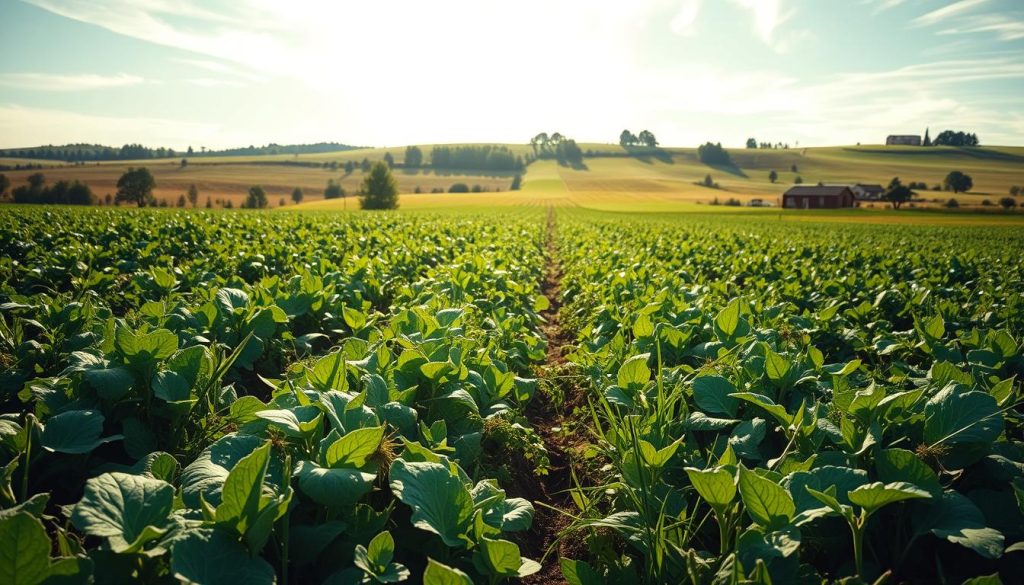
Cover crops do many things at once. They stop erosion, fight weeds, break pest cycles, and help with carbon sequestration. They’re a great start for farmers moving to sustainable practices, showing results quickly.
Selecting the Right Cover Crop Species
Choosing the right cover crop is key. Legumes like clover and vetch fix nitrogen, perfect for crops like corn. Grasses like rye and oats grab leftover nutrients and fight compaction.
Think about your climate, soil, and main crops when picking. In cold areas, winter-hardy cereals like cereal rye do well. Buckwheat is great in short summers. Many farmers find mixes better than single crops because they offer more benefits.
| Cover Crop Type | Best Season | Primary Benefits | Rotation Placement |
|---|---|---|---|
| Cereal Rye | Fall-Spring | Erosion control, weed suppression | Before spring crops |
| Crimson Clover | Fall-Spring | Nitrogen fixation, pollinator habitat | Before summer grains |
| Buckwheat | Summer | Quick growth, phosphorus mobilization | Short windows between crops |
| Radish/Turnips | Fall | Deep soil penetration, nutrient capture | Before no-till plantings |
Green Manure Management
Green manure cover crops add nutrients to your soil. Timing is key. Legumes should flower before being cut to fix nitrogen.
For biomass-heavy crops like rye, cut them early if your soil holds nitrogen. The type of cover crop affects how fast nutrients are released. Younger plants break down quicker, while older ones improve soil structure.
Timing and Termination Strategies
Planting and ending cover crops at the right time is crucial. Seed immediately after harvesting to ensure growth. Special equipment helps plant into standing crops, giving more growing days.
Choose your termination method wisely. Roller-crimpers work for grasses, while mowing is good for legumes. In wet conditions or for tough crops, herbicides might be needed, but many are finding organic ways to end cover crops.
Intercropping: Maximizing Field Efficiency
Farmers are turning to intercropping to grow more with less. This method involves growing different crops together. It’s a big change from growing just one crop at a time.
Intercropping makes better use of space, light, water, and nutrients. By choosing the right plants, farmers create systems that work like nature. This way, they use resources better and fight pests and diseases.
Companion Planting Fundamentals
Intercropping starts with knowing how plants work together. It’s about using resources in different ways. For example, some plants reach deep into the soil, while others stay close to the surface.
Some plants help each other out. Legumes, for instance, make nitrogen that other plants can use. Farmers pick and arrange plants to help each other and avoid problems.
There are many ways to set up intercropping systems:
- Strip cropping: Growing different crops in alternating strips wide enough for mechanical harvesting
- Relay cropping: Planting a second crop before the first is harvested
- Mixed intercropping: Completely mixing two or more crops with no distinct row arrangement
When planning intercropping, think about your equipment. Many farmers adapt their tools or make new ones to handle these complex plantings.
Successful Crop Combinations
Some crop pairs work really well together. The “Three Sisters” method, used by Indigenous Americans, is a classic example. It combines corn, beans, and squash. Corn supports beans, which fix nitrogen, and squash keeps weeds down and saves water.
Today, farmers use new combinations that work for modern farming. Cereal grains and legumes are a good pair. They balance out nitrogen use and production. Some farmers grow wheat with clover, which keeps growing after wheat is harvested.
| Intercropping Combination | Benefits | Challenges | Best Suited For |
|---|---|---|---|
| Corn + Beans + Squash | Nitrogen fixation, structural support, weed suppression | Mechanical harvesting difficulties | Small-scale diverse farms |
| Wheat + Clover | Extended soil coverage, nitrogen addition, erosion control | Timing clover establishment | Grain farms transitioning to reduced tillage |
| Sunflower + Soybeans | Improved light utilization, pollinator habitat | Different harvest timing | Diversified row crop operations |
| Barley + Peas | Balanced nutrition, reduced lodging | Determining optimal seeding rates | Livestock operations needing high-protein forage |
Intercropping has big benefits but also challenges. Harvesting can be tricky, needing careful timing or special tools. Some farmers harvest each crop separately, while others use new ways to sort them after harvest.
Despite the challenges, the advantages of intercropping are worth trying. Start small to see what works for your farm. As you get better, you can grow more intercropped areas. This will make your farm more sustainable and profitable.
No-Till Farming and Conservation Rotation Systems
Combining conservation tillage with crop rotation is key to regenerative farming. This approach minimizes soil disturbance and promotes diverse crops. Together, they form the backbone of sustainable agriculture today.
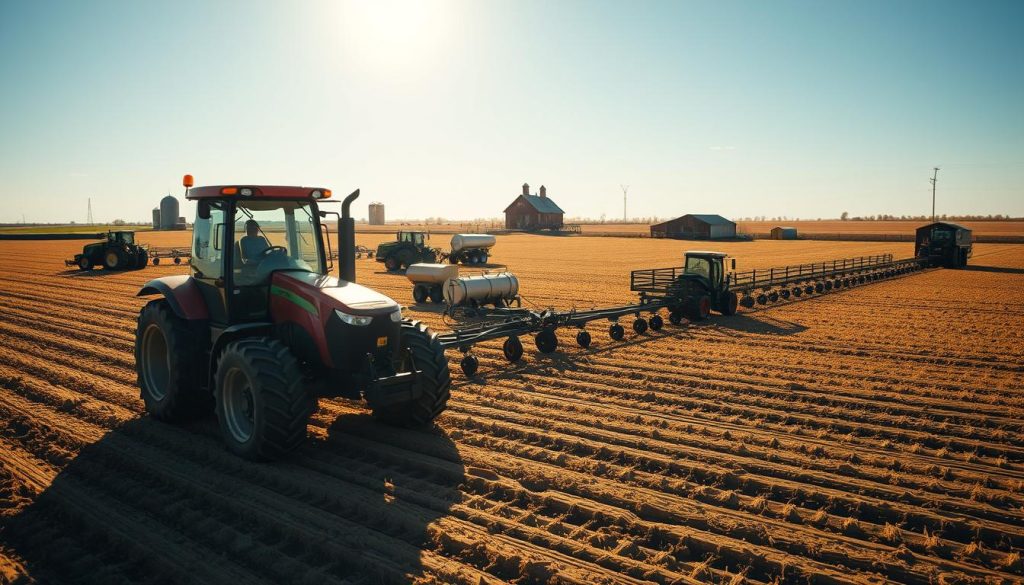
Conservation tillage includes reduced tillage and no-till systems. These methods keep the soil intact, improving crop rotation effectiveness. They also protect the soil ecosystem.
Benefits of Reduced Tillage in Rotations
No-till farming improves soil structure. Earthworms and decomposing roots create channels for water. This helps during heavy rains.
Carbon sequestration increases in no-till systems. Organic matter builds up in the soil, supporting microbes. These microbes help nutrients cycle between crops.
Erosion reduction is another big plus. Crop residue protects the soil from erosion. This is crucial during crop changes in the rotation.
| Aspect | Conventional Tillage | No-Till with Rotation | Long-Term Impact |
|---|---|---|---|
| Soil Organic Matter | Decreases 1-2% annually | Increases 0.1-0.2% annually | Improved fertility and structure |
| Fuel Usage | 7-10 gallons/acre | 2-3 gallons/acre | Lower carbon footprint |
| Water Infiltration | 0.5-1 inch/hour | 2-3 inches/hour | Drought resilience |
| Earthworm Population | 10-20 per square foot | 30-100 per square foot | Enhanced nutrient cycling |
Overcoming No-Till Challenges
Switching to no-till takes time and planning. Farmers might see yield drops at first. Cover crops can help speed up soil adjustment.
Buying new equipment is a big step. Specialized tools are needed for no-till farming. Dave Brandt from Ohio gradually updated his farm and equipment.
Weed control changes in no-till. Farmers use crop sequences, cover crops, and herbicides. The Rodale Institute shows diverse rotations and cover crops can cut herbicide use by 75%.
Managing soil temperature is hard in cold climates. Farmers choose cold-tolerant varieties and adjust planting times. This helps the soil warm up faster.
Crop Diversification Strategies for Resilience
In today’s changing climate, crop diversification is key for sustainable farming. Basic crop rotations are good, but adding more crops makes your farm stronger against many challenges. It’s not just about growing more. It’s about creating a system that works together.
Farmers who diversify their crops see better yields, lower costs, and more resilience against bad weather. This comes from the complex relationships between different plants on their farms.
Beyond Basic Rotations
Going beyond simple rotations leads to powerful farming systems. These systems are like natural ecosystems. Advanced diversification adds complexity and strength to your farm.
Here are ways to take your rotation to the next level:
- Parallel rotations – Running multiple sequences in different fields boosts diversity while following good rotation rules.
- Mosaic farming – Mixing different crops and habitats across your land helps beneficial insects and stops pests.
- Perennial integration – Adding perennial crops, forages, or agroforestry to annual systems keeps soil covered and diverse all year.
Farmer James Wilkins in Iowa started parallel rotations five years ago. He divided his 500 acres into three systems. “My farm is more resilient now,” he says. “When one crop struggles, others do well in different parts.”
Building Farm Biodiversity
True resilience comes from biodiversity across your farm. This “planned biodiversity” builds a web of helpful relationships that support crops naturally.
More diverse crops bring many ecological benefits:
- Supports diverse soil microbiome communities that improve nutrient cycling
- Creates habitat for beneficial insects that control pests
- Improves pollinator abundance and diversity
- Reduces disease pressure through biological suppression
- Enhances water infiltration and retention through varied root structures
Start small with new diversity strategies. Add one or two new crops before trying more complex systems. Many farmers find success by adding specialty crops that open new markets and improve farm ecology.
Managing more complexity needs good planning and record-keeping. Digital farm management platforms can track diverse plantings and outcomes. The learning curve is steep, but the benefits of organic farming practices and crop diversification are worth it.
Integrated Pest Management Through Strategic Rotations
Using crop rotations is a smart way for farmers to cut down on chemicals. By planning crop sequences, farmers can stop pests, diseases, and weeds naturally. This method saves money and makes farming stronger.
It takes more planning than just spraying at set times. But it offers many benefits that help the whole farm. Let’s see how rotation strategies help manage pests without chemicals.
Breaking Pest Cycles Naturally
Pests often target specific plants. By changing crops, farmers can stop pests from finding food. This simple step can greatly lower pest numbers without chemicals.
For example, corn rootworms only eat corn roots. Planting soybeans or small grains after corn starves them. Rotating potatoes with other crops stops Colorado potato beetles.
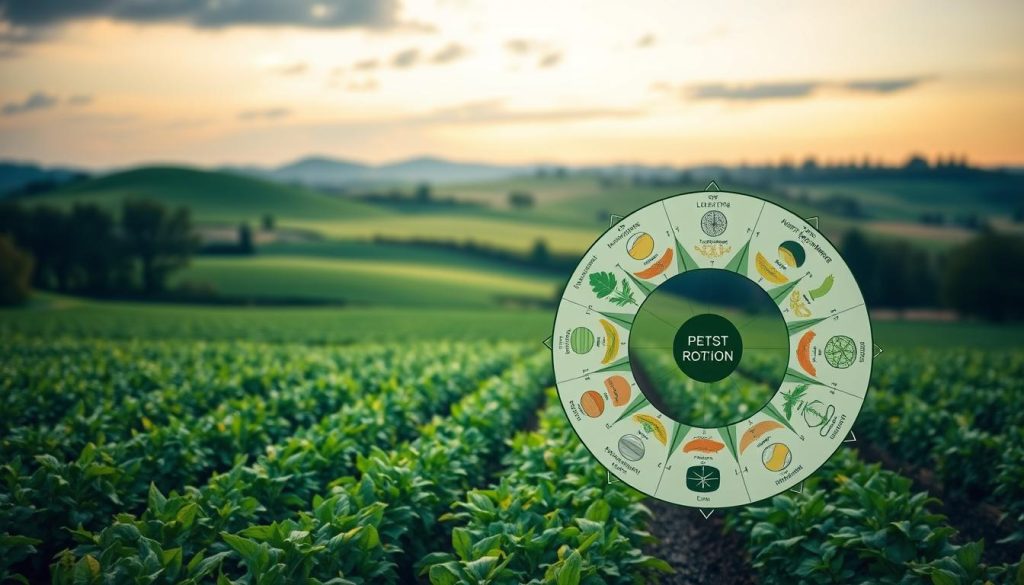
When and how to rotate crops is key. Many pests follow seasonal patterns. By planting non-host crops at the right time, farmers can starve pests when they’re most weak.
Disease Suppression Techniques
Soil-borne diseases build up when the same crop is grown over and over. Good rotations stop this by several ways.
Changing crops changes the soil’s life, helping good bugs fight off bad ones. Some crops, like brassicas, release chemicals that kill off harmful fungi and bacteria.
Also, giving crops a break lets natural processes kill off diseases. For example, not planting wheat for two years cuts down on take-all root rot later.
Some plants also help good fungi grow, making future crops stronger and more resistant to disease.
Weed Management Benefits
Rotations mess up weed lifecycles in many ways. Different crops compete with weeds, keeping any one weed from taking over.
Switching between warm and cool-season crops messes up weeds’ plans. For example, winter wheat fights summer weeds, while soybeans keep winter weeds down.
Rotation also lets farmers use different ways to control weeds. This way, they can avoid weeds getting resistant to herbicides.
| Rotation Strategy | Pest Control Benefit | Disease Suppression | Weed Management |
|---|---|---|---|
| Corn-Soybean-Small Grain | Disrupts corn rootworm cycle | Reduces corn stalk rot | Controls summer annual weeds |
| Vegetable-Cover Crop-Grain | Reduces vegetable-specific insects | Suppresses soil-borne pathogens | Smothers weeds with cover crops |
| Cotton-Peanut-Corn | Breaks nematode cycles | Reduces southern blight | Varies herbicide timing |
| Potato-Grain-Alfalfa | Controls potato beetles | Reduces verticillium wilt | Suppresses weeds with alfalfa |
Technology Tools for Modern Crop Rotation Planning
Today, farmers have access to many new technologies. These tools help make crop rotation planning easier and more effective. From simple digital tracking to advanced analytics, technology supports sustainable farming.
Software Solutions for Rotation Management
Farm management software has changed a lot lately. It now has special features for planning crop rotations. These tools help farmers keep track of field histories and plan future rotations.
For beginners, simple spreadsheet templates are a good start. They help organize crop sequences and field data. These tools are easy to use and offer big improvements over paper records.
More advanced platforms like FarmLogs, Granular, and Agworld do even more. They integrate rotation planning with other farm management tasks. These systems suggest rotations based on soil health, past crop performance, and market trends.
| Software Solution | Key Features | Best For | Learning Curve |
|---|---|---|---|
| Basic Spreadsheets | Simple tracking, customizable templates | Small farms, beginners | Low |
| FarmLogs | Field mapping, yield analysis, rotation planning | Medium-sized operations | Medium |
| Granular | Comprehensive planning, financial analysis, rotation optimization | Large commercial farms | High |
| Agworld | Collaborative planning, record keeping, rotation visualization | Farms with multiple decision makers | Medium |
Data-Driven Decision Making
Modern rotation planning relies on detailed field data. Soil tests, yield data, weather, and pest observations guide better rotation choices. This data is crucial for making informed decisions.
GPS mapping helps farmers divide fields into zones. This approach allows for tailored rotation plans for each zone. It maximizes crop rotation benefits.
Minnesota farmer Dave Brandt uses simple digital tools and observation for his rotation decisions. He tracks yields and soil test results in a basic program. This data helps him make better planting choices.
Variable rate application technologies further enhance rotation benefits. They adjust inputs based on field conditions and crop needs. When used with rotation planning software, they help reduce costs and improve sustainability.
Even farmers new to technology can benefit from these advances. Many agricultural extension offices offer training. Equipment dealers also provide support for technology adoption. Start with tools that fit your comfort level and gradually build your skills.
Economic Analysis: Making Rotation Systems Profitable
Switching to advanced rotation systems needs careful planning. Many farmers worry about losing money. But, done right, these systems can save the environment and make money.
Understanding the costs at each step helps farmers make smart choices. This supports their land and their business.
Short-Term Considerations
Starting a new rotation system costs money upfront. You might need new tools, different seeds, and changes in how you work the land. At first, your crops might not grow as much as they used to.
To reduce risks, start small. Use 20-30% of your land to test the system. Many programs offer grants to help with sustainable farming.
By using legumes, you can cut down on nitrogen use. This can save you 30-50% on some inputs. Making detailed budgets for each crop helps find ways to save money.
Long-Term Financial Benefits
Over time, the benefits of good rotation systems grow. Your soil gets healthier, and you spend less on inputs. Farmers using diverse rotations use 20-60% less fertilizer and 30-80% less pesticides.
These systems also make your farm more resilient to weather. They handle drought and excess water better, saving on insurance and keeping income steady.
A 10-year study in Iowa found diverse rotations can be as profitable as traditional farming. They save money on inputs and offer premium market opportunities.
Marketing Advantages of Sustainable Practices
Good rotation systems open up premium markets. Organic farming becomes easier, raising crop values by 30-100%.
New certifications like Regenerative Organic add more value. They focus on rotation as key to sustainable farming.
Direct marketing can highlight your sustainable farming. Telling customers about your practices can increase prices by 15-25%.
Many farms have seen success with this approach. Gabe Brown in North Dakota and Jared Zystro in Vermont have turned their farms around. They now sell value-added products that showcase their sustainable farming.
The Future of Farming: Why Advanced Rotation Systems Will Lead the Way
Climate challenges are getting tougher, and advanced crop rotation systems are key to resilient farming. These systems protect the soil and help farms succeed in changing times. They also meet the growing demand for food.
Carbon markets offer a new chance for farmers using diverse rotations. By storing carbon in healthy soils, farms can earn money while fighting climate change. It’s simple: better rotations mean more carbon stored and more money.
People want to eat food grown in sustainable ways. Retailers and food companies look for suppliers who care about the environment. This creates a market for farmers who use rotation systems.
Innovative farmers are leading the way. In Iowa, they mix unusual crops with new tech to save money. In California, vegetable farmers use complex rotations to avoid harmful pesticides.
Starting this journey takes money and learning, but early starters gain valuable experience. Every step toward using more crops builds a farm’s strength. Whether it’s adding one cover crop or changing your whole system, it makes your farm stronger.
The future is for farmers who see their land as ecosystems, not just places to grow crops. By using advanced rotation systems now, you’re preparing for the future. You’re farming for generations to come.

